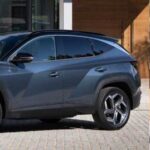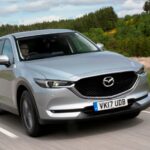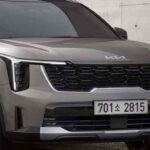newcar takes center stage as we explore the latest developments in the automotive world, capturing the essence of innovation and excitement that new models bring. Each year, a wave of fresh designs enters the market, offering cutting-edge technology and enhanced performance that cater to diverse consumer needs.
This year’s lineup features an array of impressive models, each boasting unique specs and features that set them apart. From electric vehicles to high-performance sedans, the choices are vast, ensuring there’s a new car for every type of driver.
New Car Models

The automotive industry is witnessing an exciting year with the launch of several cutting-edge car models that emphasize performance, technology, and sustainability. As manufacturers strive to meet the growing demand for advanced features and eco-friendly options, the latest releases reflect these trends while catering to diverse consumer needs.This year, five notable car models have set new benchmarks in design, technology, and performance.
From electric vehicles that promise zero emissions to high-performance gasoline options, these cars showcase the innovation driving the automotive sector forward. Below is a detailed overview of these new models, highlighting their key features and specifications.
Latest Car Models Overview
The following section provides an in-depth look at five new car models released this year, each representing a unique blend of style, technology, and performance:
- 2023 Tesla Model S Plaid: This high-performance electric sedan boasts a 0-60 mph time of just 1.99 seconds, a range of approximately 390 miles, and features such as Autopilot and a minimalist interior with a 17-inch touchscreen display.
- 2023 Ford Mustang Mach-E: A pioneering electric SUV, the Mach-E offers up to 300 miles of range, Ford’s advanced driving assistance systems, and an impressive cargo capacity, making it a versatile option for families and performance enthusiasts alike.
- 2023 Honda Civic: The latest iteration of this popular compact car includes a turbocharged engine, improved fuel efficiency with up to 42 mpg on the highway, and a suite of safety features such as Lane Keeping Assist and Collision Mitigation Braking.
- 2023 Mercedes-Benz EQS: This luxury electric sedan combines cutting-edge technology with opulent design, offering a range of up to 478 miles, a state-of-the-art infotainment system, and advanced safety features like Active Distance Assist.
- 2023 Toyota GR86: A sports car that emphasizes driving pleasure, the GR86 features a naturally aspirated 2.4L flat-four engine, lightweight design for agile handling, and a driver-focused interior, appealing to car enthusiasts seeking thrills.
Performance Comparison
To provide a clearer view of how these new models stack up against each other, the following table Artikels key performance metrics:
| Model | Power (hp) | 0-60 mph (seconds) | Range (miles) | Fuel Economy (mpg) |
|---|---|---|---|---|
| Tesla Model S Plaid | 1020 | 1.99 | 390 | N/A |
| Ford Mustang Mach-E | 480 | 3.5 | 300 | N/A |
| Honda Civic | 180 | 7.0 | N/A | 42 (highway) |
| Mercedes-Benz EQS | 516 | 4.1 | 478 | N/A |
| Toyota GR86 | 228 | 6.1 | N/A | 30 (combined) |
The automotive landscape of 2023 showcases a blend of speed, sustainability, and innovation, setting the stage for future developments in the industry.
Buying a New Car: Newcar
Purchasing a new car can be an exhilarating yet daunting experience. With numerous options available and various financial considerations, having a structured approach can simplify the process. This guide aims to break down the buying process into manageable steps while providing essential financial insights and a practical checklist.
Step-by-Step Process for Purchasing a New Vehicle
A systematic approach to buying a new car ensures that buyers make informed decisions and avoid common pitfalls. The following step-by-step process Artikels the critical stages involved:
- Determine Your Needs: Assess what you need in a vehicle, considering factors such as size, fuel efficiency, and primary usage.
- Set a Budget: Establish a clear budget that includes not only the purchase price but also taxes, fees, insurance, and maintenance costs.
- Research Models: Explore different makes and models that fit your needs and budget, utilizing resources like automotive websites and consumer reviews.
- Visit Dealerships: Schedule visits to local dealerships to see the cars in person, taking test drives to evaluate comfort and performance.
- Negotiate Pricing: Once a preferred model is selected, engage in negotiations regarding the sales price and available incentives.
- Review Financing Options: Consider different financing methods, including loans, leases, and cash purchases, to determine the most suitable option.
- Finalize the Purchase: After securing financing and agreeing on a price, review and sign all necessary documents to complete the purchase.
Financial Aspects Including Budgeting and Financing Options
Understanding the financial implications of buying a new car is vital for making strategic decisions. Budgeting for a new vehicle involves several key factors:
“A general rule of thumb is that your car expenses should not exceed 15% of your monthly income.”
When considering financing options, buyers typically encounter three primary methods:
- Paying Cash: This option involves paying the full price upfront, eliminating any interest payments.
- Loans: Buyers can finance through banks or credit unions, often securing lower interest rates than dealership financing.
- Leasing: Leasing allows for lower monthly payments and the ability to drive a new vehicle every few years, though ownership is not attained.
It is essential to compare offers from multiple lenders to ensure the most favorable financing terms.
Checklist for Considerations Before Making a Purchase
Having a comprehensive checklist can help shoppers stay organized and focused during the buying process. Prior to making a purchase, consider the following essential points:
- Vehicle History Reports: For used cars, obtain a report to check for accidents or title issues.
- Warranty Options: Understand the warranty coverage available for the vehicle, including duration and what is covered.
- Insurance Costs: Get insurance quotes to factor into your overall budget, as some models may have higher premiums.
- Fuel Economy: Consider the vehicle’s fuel efficiency and how it aligns with your driving habits and budget.
- Resale Value: Research the expected resale value of the car to ensure you are making a wise long-term investment.
This checklist serves to reinforce informed decision-making and can significantly influence the satisfaction with the purchase.
New Car Technology
The automotive industry is experiencing a technological revolution that is reshaping how we think about vehicles. From advancements in safety features to the integration of smart technologies, new car technology is designed to enhance the driving experience, improve efficiency, and ensure user safety. This segment delves into the latest technological advancements that are defining new car models.Recent developments in automobile technology are not only focused on performance but also on environmental sustainability.
The all-new Kia Sorento 2024 boasts impressive upgrades in both technology and design, making it a strong contender in the SUV market. With enhanced safety features and a spacious interior, this model caters perfectly to families and adventure seekers alike. Don’t miss out on experiencing the blend of comfort and performance that the Sorento has to offer.
Electric vehicles (EVs) have emerged as a significant force in the market, driven by advancements in battery technology, charging infrastructure, and software integration. The transition to electric mobility has led to innovations such as regenerative braking, which recaptures energy during braking, and vehicle-to-grid (V2G) technology that allows EVs to return power to the grid. These technologies are fundamentally altering the landscape of the automotive market, making electric vehicles more accessible and appealing to consumers.
For those looking to combine style and efficiency, the new Mitsubishi sedan range delivers impressive fuel economy alongside a sleek design. These vehicles are tailored for urban driving, making them an excellent choice for city dwellers who want a reliable and stylish ride. Explore the features that set Mitsubishi sedans apart from the competition.
Must-Have Tech Features in Modern Vehicles
In today’s market, consumers expect their vehicles to be equipped with advanced technology that enhances safety, connectivity, and convenience. Here are some essential tech features that are increasingly becoming standard in new cars:
- Adaptive Cruise Control: This feature automatically adjusts the car’s speed to maintain a safe distance from the vehicle ahead, enhancing safety during highway driving.
- Lane Keeping Assist: A system that helps keep the vehicle centered in its lane, reducing the likelihood of unintended lane departures.
- Infotainment Systems: Modern vehicles come with integrated navigation, Bluetooth connectivity, and smartphone compatibility (such as Apple CarPlay and Android Auto), providing seamless access to music, maps, and communication.
- Advanced Driver Assistance Systems (ADAS): Technologies like blind-spot monitoring, parking assistance, and automatic emergency braking improve driver awareness and reduce accident risk.
- Wireless Charging: Many new cars feature built-in wireless charging pads for smartphones, eliminating the need for cords and clutter within the vehicle.
- Connected Car Technology: Features that allow the vehicle to communicate with other devices, providing real-time data on traffic, weather, and vehicle health, enabling proactive maintenance alerts.
- 360-Degree Cameras: A comprehensive view around the vehicle during parking or maneuvering, utilizing multiple cameras to enhance spatial awareness.
The integration of such cutting-edge technology not only elevates the driving experience but also sets a new standard for safety and efficiency in the automotive industry.
New Car Reviews
As the automotive industry continues to evolve, new car models are introducing cutting-edge technologies and designs that excite consumers. This section highlights comprehensive reviews of popular new car models, comparing user experiences with expert opinions to provide valuable insights into their performance, comfort, and overall value. Review formats generally consist of structured evaluations that highlight various aspects of a car, ensuring potential buyers can make informed decisions.
Key categories include performance, interior comfort, technology integration, safety features, and pricing.
In-Depth Review of the 2023 Honda Accord, Newcar
The 2023 Honda Accord stands out in the midsize sedan segment for its blend of sophistication and technology. Its well-rounded attributes have garnered attention from both users and experts alike.
- Performance: The Accord offers two engine options: a robust 1.5-liter turbocharged inline-4 that produces 192 horsepower and a more powerful 2.0-liter turbocharged inline-4 generating 252 horsepower. The hybrid variant also provides an efficient driving experience without sacrificing power.
- Comfort: Inside, the Accord boasts spacious seating for five, with high-quality materials that create a premium ambiance. The rear legroom is among the best in its class, allowing for comfortable journeys even on longer drives.
- Technology: Equipped with a standard 12.3-inch touchscreen, the Accord features an intuitive infotainment system that supports both Apple CarPlay and Android Auto, ensuring seamless connectivity for users.
- Safety Features: The Honda Sensing suite of safety features is standard, including adaptive cruise control, lane-keeping assist, and collision mitigation braking, enhancing overall driver confidence.
- Value: With a starting price that remains competitive in its segment, the Accord offers a high resale value, making it a smart investment for buyers.
“The 2023 Honda Accord combines performance with comfort and advanced safety features, making it a top choice in the midsize sedan market.”
Comparison of User Experiences and Expert Opinions
User experiences often reflect day-to-day practicality, while expert reviews provide an analytical perspective on vehicle performance and features. This comparison can highlight discrepancies and alignments between consumer expectations and professional assessments.Users appreciate the Accord’s reliability and fuel economy, with many noting its smooth ride and responsive handling as standout characteristics. Experts, conversely, emphasize the vehicle’s advanced technology and safety ratings, often citing its impressive crash test results.Some common ratings from various sources include:
- Consumer Reports: Rated the Accord a solid 87/100 for its overall performance and value.
- Car and Driver: Gave it a 9 out of 10, praising the engaging driving dynamics and generous interior space.
- J.D. Power: Highlighted customer satisfaction with a score of 82%, reflecting overall trust in brand reliability.
The culmination of user feedback and expert opinions establishes a comprehensive profile of the Honda Accord, underscoring its reputation as a leading choice among new car buyers.
Structured Review Format for New Car Models
A structured review format provides clarity and consistency, allowing potential buyers to quickly assess critical aspects of a new car. A recommended format includes the following categories:
| Category | Description |
|---|---|
| Performance | Evaluation of engine options, handling, and driving experience. |
| Comfort | Assessment of seating, spaciousness, and materials used in the interior. |
| Technology | Overview of infotainment features, connectivity, and user interface. |
| Safety | Details about available safety features and crash test ratings. |
| Value | Analysis of pricing, resale value, and warranty offerings. |
This structured approach not only facilitates informed decision-making but also standardizes the review process, allowing consumers to easily compare different models based on consistent criteria.
Future Trends in Automobiles
The automotive industry is on the brink of transformative changes, driven by advancements in technology, societal shifts, and increasing environmental awareness. These future trends not only influence how vehicles are designed and manufactured but also how they are used, impacting the daily lives of consumers globally. Understanding these trends is essential for anyone interested in the future of mobility.One of the most significant trends reshaping the automotive landscape is the advent of autonomous driving technology.
This innovation promises to revolutionize transportation by enhancing safety, reducing traffic congestion, and providing greater accessibility for individuals unable to drive. The integration of artificial intelligence (AI) and machine learning into vehicles allows them to analyze vast amounts of data in real-time, making informed decisions without human intervention.
Impact of Autonomous Driving Technology
Autonomous driving technology is poised to greatly influence transportation systems and urban development. As vehicles become self-driving, several key impacts will emerge:
- Enhanced Safety: Self-driving cars aim to reduce accidents caused by human error, which accounts for approximately 94% of traffic incidents according to the National Highway Traffic Safety Administration (NHTSA).
- Traffic Management: Autonomous vehicles can communicate with each other and traffic systems, optimizing traffic flow and reducing congestion. This interconnectedness is expected to improve the efficiency of road use significantly.
- Accessibility: Self-driving technology can provide reliable transportation for individuals who cannot drive, such as the elderly or disabled, thereby enhancing their independence and mobility.
- Cost Reduction: The potential for reduced vehicle ownership costs and lower insurance premiums as autonomous vehicles minimize accidents is a promising benefit for consumers.
As the development of autonomous vehicles progresses, regulatory frameworks and infrastructure will need to adapt to accommodate these innovations, ensuring safety and efficiency on public roads.
Environmental Considerations in New Car Designs
The automotive industry’s shift towards sustainability is evident in the emphasis on environmentally friendly designs. Manufacturers are increasingly adopting practices that minimize their carbon footprint while meeting consumers’ growing demand for greener vehicles. Key environmental considerations include:
- Electric and Hybrid Vehicles: The rise of electric and hybrid vehicles, aimed at reducing greenhouse gas emissions, reflects a significant trend in new car designs. For instance, Tesla’s Model 3 has made electric driving more accessible and appealing to the mass market.
- Recyclable Materials: Car manufacturers are exploring the use of sustainable materials in vehicle production, such as recycled plastics and bio-based composites, which minimize resource depletion and waste.
- Fuel Efficiency: Enhancements in engine technology, such as turbocharging and lightweight materials, contribute to improved fuel efficiency, thereby lessening the overall environmental impact of combustion engines.
- Manufacturing Processes: The adoption of cleaner manufacturing processes, including the use of renewable energy sources and waste reduction initiatives, is becoming increasingly important for automakers committed to sustainability.
As consumers become more environmentally conscious, automakers are under pressure to innovate and produce vehicles that align with sustainable practices, contributing to a greener future for the automotive industry.







